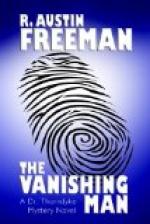“But there is a third possibility, which, strange to say, no one seems to have suggested. Supposing that the visitor was not John Bellingham at all, but someone who was personating him? That would dispose of the difficulties completely. The strange disappearance ceases to be strange, for a personator would necessarily make off before Mr. Hurst should arrive and discover the imposture. But if we accept this supposition, we raise two further questions: ‘Who was the personator?’ and ’What was the object of the personation?’
“Now, the personator was clearly not Hurst himself, for he would have been recognised by his housemaid; he was therefore either Godfrey Bellingham or Mr. Jellicoe or some other person; and as no other person was mentioned in the newspaper reports I confined my speculations to these two.
“And, first, as to Godfrey Bellingham. It did not appear whether he was or was not known to the housemaid, so I assumed—wrongly, as it turns out—that he was not. Then he might have been the personator. But why should he have personated his brother? He could not have already committed the murder. There had not been time enough. He would have had to leave Woodford before John Bellingham had set out from Charing Cross. And even if he had committed the murder, he would have had no object in raising this commotion. His cue would have been to remain quiet and know nothing. The probabilities were all against the personator being Godfrey Bellingham.
“Then could it be Mr. Jellicoe? The answer to this question is contained in the answer to the further question: What could have been the object of the personation?
“What motive could this unknown person have had in appearing, announcing himself as John Bellingham, and forthwith vanishing? There could only have been one motive: that, namely, of fixing the date of John Bellingham’s disappearance—of furnishing a definite moment at which he was last seen alive.
“But who was likely to have had such a motive? Let us see.
“I said just now that if Mr. Jellicoe had murdered John Bellingham and disposed of the body in the mummy-case, he would have been absolutely safe for the time being. But there would be a weak spot in his armour. For a month or more the disappearance of his client would occasion no remark. But presently, when he failed to return, inquiries would be set on foot; and then it would appear that no one had seen him since he left Queen Square. Then it would be noted that the last person with whom he was seen was Mr. Jellicoe. It might, further, be remembered that the mummy had been delivered to the Museum some time after the missing man was last seen alive. And so suspicion might arise and be followed by disastrous investigations. But supposing it should be made to appear that John Bellingham had been seen alive more than a month after his interview with Mr. Jellicoe and some weeks after the mummy had been deposited in the Museum? Then Mr. Jellicoe would cease to be in any way connected with the disappearance, and henceforth would be absolutely safe.




